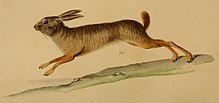
Hares and jackrabbits are mammals belonging to the genus Lepus. They are herbivores, and live solitarily or in pairs. They nest in slight depressions called forms, and their young are able to fend for themselves shortly after birth. The genus includes the largest lagomorphs. Most are fast runners with long, powerful hind legs, and large ears to dissipate body heat. Hare species are native to Africa, Eurasia and North America. A hare less than one year old is called a "leveret". A group of hares is called a "husk", a "down", or a "drove".

The lagomorphs are the members of the taxonomic order Lagomorpha, of which there are two living families: the Leporidae and the Ochotonidae (pikas). There are 110 recent species of lagomorph of which 109 are extant, including 10 genera of rabbits, 1 genus of hare and 1 genus of pika. The name of the order is derived from the Ancient Greek lagos + morphē.

Leporidae is the family of rabbits and hares, containing over 70 species of extant mammals in all. The Latin word Leporidae means "those that resemble lepus" (hare). Together with the pikas, the Leporidae constitute the mammalian order Lagomorpha. Leporidae differ from pikas in that they have short, furry tails and elongated ears and hind legs.

Cottontail rabbits are in the Sylvilagus genus, which is in the Leporidae family. They are found in the Americas. Most Sylvilagus species have stub tails with white undersides that show when they retreat, giving them their characteristic name. However, this feature is not present in all Sylvilagus, nor is it unique to the genus.

The Cape hare, also called the brown hare and the desert hare, is a hare native to Africa and Arabia extending into India.
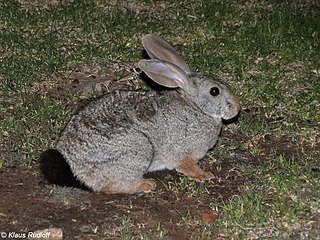
Jameson's red rock hare is a leporid found only on the continent of Africa, mostly in the southern portion of the continent. Zimbabwe and Namibia are thought to have the largest populations of the red rock hare and it is said to be found throughout both countries. South Africa has a population of this red rock hare but it is only found in the northwestern part of the country. Botswana also has a population in the Tswapong Hills.
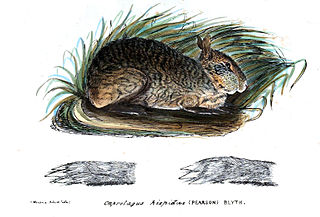
The hispid hare, also called Assam rabbit and bristly rabbit, is a leporid native to South Asia, whose historic range extended along the southern foothills of the Himalayas. Today, its habitat is highly fragmented with an area of occupancy estimated at less than 500 km2 (190 sq mi) extending over an area of 5,000 to 20,000 km2. Populations experienced a continuing decline in suitable habitat due to increasing agriculture, flood control, and human development. It is therefore listed as Endangered on the IUCN Red List since 1986. It is the only species in the genus Caprolagus.
Vincent's bush squirrel is a species of rodent in the family Sciuridae, named in honour of Jack Vincent. It is endemic to Mozambique. Its natural habitat is subtropical or tropical moist montane forests, and it is threatened by habitat loss.
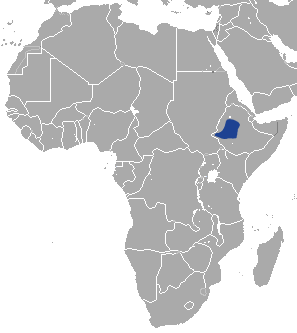
The Ethiopian hare is a species of mammal in the family Leporidae. It was first described in 1903, by the British mammalogist Oldfield Thomas. The dorsal pelage is brownish buff, and is finely grizzled with black. The ventral pelage is fluffy and white in colour. Endemic to Ethiopia, it is found in the Afromontane Biozone of Ethiopia, and in the borders of the Sudanian Savanna Biozone. It is rated as a least concern species by the International Union for Conservation of Nature.

The Ethiopian highland hare or Starck's hare is a medium-sized species of mammal in the rabbit and hare family, Leporidae. Its dorsal pelage is grizzled, buff white and spotted and streaked with black, while its belly fur is pure white and fluffy. It is endemic to the Ethiopian Highlands, ranging over the Afroalpine regions of the Shoa, Bale, and Arsi Provinces of Ethiopia. A herbivore, it mostly feeds on moorland grasses. The IUCN rates it as a species of least concern.
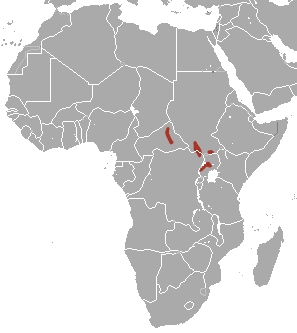
The Bunyoro rabbit or Central African rabbit is a species of mammal in the family Leporidae. It is monotypic within the genus Poelagus. It is found in central Africa and its typical habitat is damp savannah, often with rocky outcrops.

The Natal red rock hare or greater red rock hare is a species of mammal in the family Leporidae. It has a slightly grizzled, grayish brown head and reddish brown upperparts. The dense fur is thick and rougher than other rock hares. It is endemic to Africa, and found in southeastern provinces of South Africa, eastern Lesotho, Eswatini, and southern Mozambique. It is a herbivore, primarily feeding on grass. It breeds throughout the year, and one or two pups are usually born in the summer. It is rated as a species of least concern on the IUCN Red List of Endangered Species.

Smith's red rockhare, Smith's red rock hare or Smith's red rock rabbit is a species of mammal in the family Leporidae, and is the smallest member of the genus Pronolagus. The upperparts and gular collar are reddish brown in colour. It has warm, brown, grizzled, thicker hairs at the back of the body, and white to tawny, thinner underfur. It is native to Africa, found in parts of Kenya, Lesotho, Malawi, Namibia, South Africa, Tanzania, Zambia and Zimbabwe. It is a folivore, and usually forages on grasses, shrubs and herbs. It breeds from September to February, and the female litters one or two offspring. The young leave the nest at three years of age. In 1996, it was rated as a species of least concern on the IUCN Red List of Endangered Species.

The Hewitt's red rock hare is a species of mammal in the family Leporidae. It had previously been classified as a subspecies of Pronolagus rupestris, but is now regarded as its own species due to differences in morphology and genetic differences in cytochrome b, and 12S rRNA.
